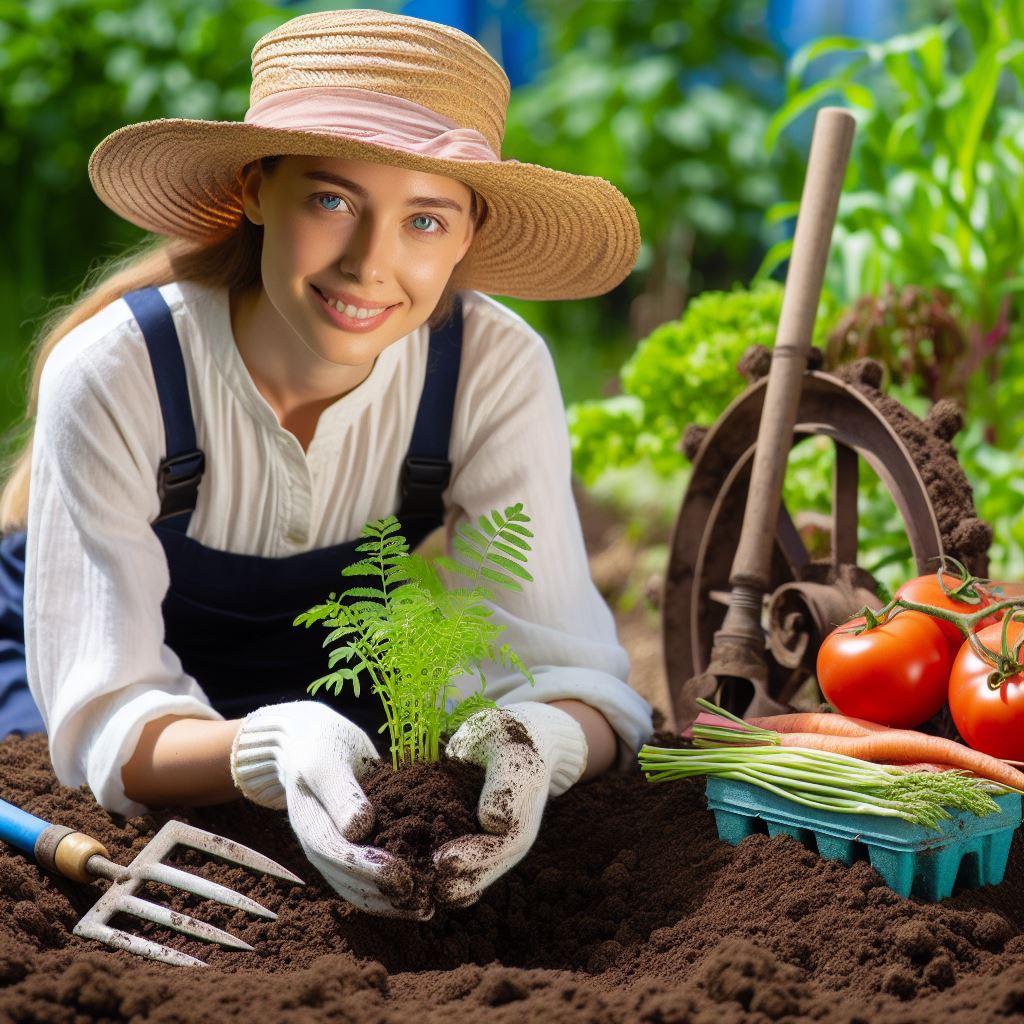Introduction
Green farming is a sustainable approach that focuses on reducing environmental impact and promoting eco-friendly agricultural practices.
One crucial aspect of green farming is soil aeration techniques, which play a vital role in maintaining soil health and enhancing crop productivity.
Soil aeration techniques involve improving the exchange of gases, primarily oxygen, in the soil.
This process enables roots to access essential nutrients and water, and also supports the growth of beneficial soil organisms.
Proper soil aeration promotes root development and allows plants to withstand stressors such as drought, disease, and nutrient imbalances.
The importance of soil aeration cannot be overstated. Compact soil restricts oxygen availability, leading to poor root growth and reduced nutrient uptake.
Without adequate aeration, soil becomes anaerobic, causing the release of harmful gases and the development of toxic conditions for plant growth.
This results in decreased crop yields and inferior quality produce.
There are several techniques available to improve soil aeration.
Mechanical methods, such as plowing, scarifying, or tilling, break up compacted soil layers and promote air circulation.
Natural methods like earthworm activity, root growth, and soil fauna contribute to aeration by creating channels for oxygen to penetrate the soil.
In recent years, innovative technologies have also been developed to enhance soil aeration.
These include the use of aerators, which mechanically penetrate the soil to alleviate compaction, and the application of organic amendments that improve soil structure and increase porosity.
In short, soil aeration plays a critical role in green farming by maintaining soil health and maximizing crop productivity.
By implementing effective soil aeration techniques, farmers can create sustainable agricultural systems that reduce environmental impact and promote long-term soil fertility.
Transform Your Agribusiness
Unlock your farm's potential with expert advice tailored to your needs. Get actionable steps that drive real results.
Get StartedWhy is soil aeration important in green farming?
The significance of soil aeration in improving crop growth and yield
Soil aeration is crucial in green farming as it allows for better root development and gas exchange.
Improves crop growth and yield by enhancing root respiration and nutrient uptake.
How proper soil aeration can enhance nutrient availability for plants
Proper soil aeration increases pore space, facilitating better water infiltration and reducing compaction.
Enhanced nutrient availability achieved through soil aeration leads to healthier plants with improved yield potential.
Soil aeration promotes the decomposition of organic matter, releasing nutrients that were previously bound.
The role of soil aeration in promoting beneficial microbial activity
Beneficial microbial activity, such as nitrogen fixation and nutrient cycling, is stimulated by adequate soil aeration.
Microorganisms break down organic matter into humus, improving soil structure and water-holding capacity.
Soil aeration also plays a pivotal role in reducing the risk of anaerobic conditions that inhibit plant growth.
The presence of oxygen in aerated soil inhibits the proliferation of harmful pathogens and pests.
Earthworms, vital for soil health, thrive in well-aerated soil and enhance nutrient cycling.
Tillage operations like plowing and harrowing help aerate the soil but can also lead to erosion.
Cover crops help improve soil structure and aeration by adding organic matter and protecting the soil surface.
Incorporating organic compost into the soil improves its structure and enhances soil aeration.
The use of cover crops and organic compost reduces the need for excessive tillage, preserving soil structure.
Reduced soil compaction through aeration allows for better root penetration and access to nutrients.
Soil aeration enhances the ability of plant roots to absorb water, reducing irrigation needs and water wastage.
Properly aerated soil promotes deep root growth, increasing plant resilience to drought and heat stress.
Green farming practices prioritize soil health, including proper aeration, to minimize the need for synthetic inputs.
Improved nutrient availability achieved through soil aeration can lead to reduced fertilizer usage and cost.
Aerated soil not only benefits crop growth but also provides a better habitat for beneficial insects and organisms.
Soil biodiversity is enhanced by proper aeration, promoting a balanced ecosystem that supports natural pest control.
Aerated soil minimizes soil erosion, as the increased pore space allows water to infiltrate rather than runoff.
Timely soil aeration helps in the management of excess rainwater, reducing the risk of waterlogging and nutrient leaching.
In fact, soil aeration is of utmost importance in green farming due to its numerous benefits.
Showcase Your Farming Business
Publish your professional farming services profile on our blog for a one-time fee of $200 and reach a dedicated audience of farmers and agribusiness owners.
Publish Your ProfileImproving crop growth, nutrient availability, and beneficial microbial activity are all results of proper soil aeration.
By promoting healthy root development and reducing the risk of waterlogging, soil aeration contributes to sustainable agricultural practices.
Adopting techniques like cover cropping and organic composting can further enhance soil aeration and overall soil health.
Investing in soil aeration practices not only benefits farmers but also contributes to a greener and more sustainable future.
Read: Healthy Soil Strategies: Microbial Magic
Traditional soil aeration techniques
Soil aeration is an important process in green farming that helps to ensure healthy plant growth and maximize crop yields.
There are various traditional soil aeration techniques that have been practiced for many years.
These techniques involve manipulating the soil in order to improve its structure and allow for better air and water movement.
Two common methods of soil aeration are tilling and plowing.
Common methods of soil aeration such as tilling and plowing
Tilling is the process of breaking up and loosening the soil using a tool or implement such as a plow or rototiller.
This technique helps to create channels and spaces in the soil, allowing for improved air circulation and water drainage.
Plowing, on the other hand, involves turning over the top layer of soil using a plow.
This helps to expose the lower layers of soil to the surface, promoting better mixing and aeration.
The advantages and disadvantages of traditional techniques
There are several advantages to using traditional soil aeration techniques.
Firstly, tilling and plowing can help to alleviate soil compaction, which often occurs as a result of heavy machinery or foot traffic.
By loosening the soil, these techniques allow plant roots to penetrate deeper into the ground, accessing nutrients and moisture more easily.
Secondly, soil aeration can improve soil fertility by increasing the availability of oxygen and nutrients to plants. This can lead to healthier plant growth and higher crop yields.
However, there are also disadvantages to consider when using traditional soil aeration techniques. One major drawback is the potential for soil erosion.
When the soil is disturbed through tilling or plowing, it becomes more vulnerable to the erosive forces of wind and water.
This can lead to the loss of valuable topsoil and nutrients, which are essential for plant growth.
Additionally, repeated tilling and plowing can disrupt soil structure and beneficial soil microorganisms, which play a vital role in nutrient cycling and soil health.
Potential negative impacts on the environment and soil structure
Another negative impact of traditional soil aeration techniques is the release of carbon dioxide and other greenhouse gases into the atmosphere.
When organic matter in the soil is exposed to oxygen during tilling or plowing, it decomposes and releases carbon dioxide.
This contributes to climate change and global warming.
Furthermore, excessive soil disturbance can damage soil structure and affect its ability to retain water, leading to increased irrigation requirements and water wastage.
In essence, while traditional soil aeration techniques such as tilling and plowing have advantages in terms of improving soil structure and fertility, they also have drawbacks.
These include soil erosion, disruption of soil structure and microorganisms, and the release of greenhouse gases.
As green farming practices evolve, it is important to explore alternative soil aeration techniques that minimize these negative impacts and promote sustainable agriculture.
Read: Sustainable Soil: Composting Do’s and Don’ts
Innovative Soil Aeration Techniques
Modern alternatives for soil aeration
Soil aeration plays a crucial role in agricultural practices as it ensures healthy soil and improved crop production.
Traditional soil aeration methods involve tilling the land, but there are modern alternatives available that are more sustainable and efficient.
This blog section will explore these innovative soil aeration techniques and their benefits.
The concept of no-till farming and its benefits in terms of soil aeration
One modern alternative to traditional tilling is the concept of no-till farming.
No-till farming is a practice where the soil is not disturbed by plowing or mechanical aeration.
It promotes the use of specialized machinery for planting, which reduces soil compaction and preserves its structure.
This technique not only helps with soil aeration but also offers several other benefits.
One of the major advantages of no-till farming is the reduction in erosion.
By leaving the soil undisturbed, the risk of soil erosion and loss of valuable topsoil is significantly reduced.
Additionally, no-till farming helps to retain moisture in the soil, as the presence of crop residue acts as a natural mulch, reducing water evaporation.
Other innovative techniques such as the use of cover crops and organic mulch
Another innovative technique for soil aeration is the use of cover crops. Cover crops are grown primarily to protect the soil and improve its structure.
Showcase Your Farming Business
Publish your professional farming services profile on our blog for a one-time fee of $200 and reach a dedicated audience of farmers and agribusiness owners.
Publish Your ProfileThese crops are typically planted during the off-season or in between cash crops.
They help to prevent erosion, keep the soil moist, and provide organic matter.
When these cover crops are terminated, their decomposition enriches the soil and enhances aeration.
Organic mulch is also gaining popularity as an effective soil aeration technique.
By applying organic materials such as straw or wood chips to the soil surface, organic mulch improves water infiltration and promotes aeration.
It acts as a protective layer, preventing soil compaction caused by raindrops and reducing weed growth. As the organic mulch breaks down, it also adds nutrients to the soil.
Furthermore, reduced tillage is another technique that promotes soil aeration without completely eliminating tilling.
By minimizing the number of times the soil is tilled, compaction can be avoided, and soil structure can be maintained.
This approach strikes a balance between conventional tillage and no-till farming, offering the benefits of both practices.
It is important to note that these innovative soil aeration techniques are not mutually exclusive. Farmers can combine different methods to maximize the benefits.
For example, using cover crops in conjunction with no-till farming can lead to even better soil aeration results.
Similarly, incorporating organic mulch into reduced tillage practices can further improve soil health.
In general, traditional soil aeration methods often involve tilling, which can lead to soil compaction and erosion.
However, modern alternatives such as no-till farming, cover crops, organic mulch, and reduced tillage offer sustainable and efficient techniques for soil aeration.
By adopting these innovations, farmers can promote healthy soil, reduce erosion, and enhance crop production.
It’s time to embrace these techniques and ensure a greener future for farming.
Read: Revitalize Your Soil: Organic Matter Secrets

Benefits of Green Farming Soil Aeration Techniques
Green farming techniques have revolutionized agriculture by implementing various soil aeration techniques.
These innovative methods bring numerous benefits to both farmers and the environment.
Contribution to Sustainable Agriculture
Green farming techniques play a crucial role in advancing sustainable agriculture practices. By improving soil aeration, these methods enhance crop yield and quality.
Proper aeration increases the availability of essential nutrients in the soil, facilitating optimal plant growth.
This, in turn, promotes sustainable farming practices by reducing the need for chemical fertilizers.
Positive Impacts on Soil Health and Fertility
Innovative soil aeration techniques contribute to healthier and more fertile soil.
Adequate aeration allows roots to access necessary oxygen, promoting their growth and overall plant vigor.
Well-aerated soil also helps in promoting diverse microbial activity, which further enhances soil fertility.
These techniques create an ecosystem where beneficial microbes can thrive, aiding in nutrient cycling and pest control.
Potential Reduction in Greenhouse Gas Emissions and Soil Erosion
Implementing green farming soil aeration techniques shows promising potential in reducing greenhouse gas emissions, particularly nitrous oxide.
Enhanced aeration decreases anaerobic conditions in the soil, preventing the production of nitrous oxide, which is a potent greenhouse gas contributing to climate change.
Furthermore, these techniques help prevent soil erosion by improving soil structure and stability.
By creating channels for water movement, aeration minimizes surface runoff, thus reducing soil erosion and nutrient loss.
List of Green Farming Soil Aeration Techniques
- Cultivating cover crops such as legumes to enhance soil organic matter and aeration.
- Reducing soil compaction through practices like minimum tillage and controlled traffic farming.
- Integrating agroforestry systems to increase soil aeration and nutrient cycling.
- Applying organic amendments like compost or manure to improve soil structure and aeration.
- Using innovative tools and machinery designed specifically for soil aeration.
To conclude, embracing green farming soil aeration techniques brings about multiple benefits.
These methods contribute to sustainable agriculture by enhancing soil health, fertility, reducing greenhouse gas emissions, and preventing soil erosion.
By implementing these techniques, farmers can achieve higher yields while minimizing environmental impacts.
Incorporating innovative soil aeration practices is a significant step towards a more sustainable and resilient agricultural system.
Read: Eco-Friendly Soil: Essential Nutrients Guide
Implementing Green Farming Soil Aeration Techniques
Green farming practices are becoming increasingly popular as farmers recognize their benefits for both the environment and crop yields.
One important aspect of green farming is soil aeration, a process that improves the oxygen supply to plant roots and enhances nutrient uptake.
In this blog section, we will discuss practical tips and guidelines for farmers interested in adopting green farming soil aeration techniques, as well as potential challenges and how to overcome them.
We will also highlight the importance of ongoing monitoring and adjustment of soil aeration practices.
Tips and Guidelines for Adopting Green Farming Practices
- Evaluate your soil: Before implementing any soil aeration techniques, it is crucial to assess the condition of your soil. Conduct a soil test to determine its structure, compaction, and nutrient content.
- Choose appropriate aeration methods: Depending on your soil type and farming practices, select the most suitable soil aeration technique. Options include mechanical aeration, such as decompaction tools, and biological aeration, such as earthworms.
- Timing is key: Perform soil aeration when the soil is not too wet or dry. Moist but not saturated soil is the ideal condition for effective aeration.
- Avoid over-aeration: While aeration is beneficial, excessive or frequent aeration can disrupt the soil’s natural ecosystem. Be mindful of balancing soil health with aeration practices.
- Consider cover crops: Planting cover crops between cash crop rotations can improve soil structure and aeration. They can enhance organic matter content and attract beneficial organisms.
- Monitor compaction: Regularly assess soil compaction levels to identify areas that require aeration. Compacted areas may exhibit poor crop growth or waterlogging issues.
Challenges and How to Overcome Them
Implementing green farming soil aeration techniques may pose some challenges, but with proper strategies, they can be overcome:
Showcase Your Farming Business
Publish your professional farming services profile on our blog for a one-time fee of $200 and reach a dedicated audience of farmers and agribusiness owners.
Publish Your Profile- Limited equipment availability: Some farmers may lack access to specialized machinery for mechanical aeration. Collaboration with local contractors or equipment sharing among farmers can help mitigate this challenge.
- Initial cost investment: Adopting green farming practices, including soil aeration, may require an initial financial investment. However, this can be offset by long-term benefits, such as improved soil fertility and reduced input costs.
- Resistance to change: Farmers who have been practicing traditional methods for years may be hesitant to adopt new techniques. Educating them about the advantages of green farming and organizing workshops can encourage their participation.
- Knowledge and training: Proper knowledge and training are essential for successful implementation of soil aeration techniques. Agricultural extension services, research institutions, and online resources can provide valuable information and training opportunities.
Importance of Ongoing Monitoring and Adjustment
Green farming practices, including soil aeration, should be seen as an ongoing process that requires regular monitoring and adjustment.
This ensures that the chosen techniques are effective and sustainable:
- Regular soil testing: Monitor the changes in soil conditions by conducting regular soil tests to assess the impact of aeration practices and identify any potential issues.
- Observe crop response: Pay attention to crop growth and yield patterns to gauge the effectiveness of soil aeration techniques. If certain areas or crops are consistently underperforming, adjustments may be needed.
- Seek expert advice: If you encounter challenges or uncertainties regarding soil aeration, consult with agronomists or agricultural experts who can provide specialized guidance.
- Promote knowledge sharing: Participating in farmer networks or agricultural associations can facilitate the exchange of experiences and best practices among farmers using green farming techniques.
By implementing green farming soil aeration techniques, farmers can enhance their crop productivity while promoting a sustainable and environmentally friendly approach.
The practical tips, guidelines, and monitoring suggestions provided in this blog section will assist farmers in adopting and optimizing soil aeration practices, leading to healthier soils and better agricultural outcomes.
Conclusion
Soil aeration techniques are pivotal for green farming’s success.
Enhanced oxygen circulation fosters nutrient absorption, optimizing plant growth. Efficient aeration mitigates soil compaction, promoting root development.
This practice bolsters water infiltration, reducing runoff and enhancing water retention.
Importantly, it curtails greenhouse gas emissions, contributing to environmental sustainability.
Encouraging farmers to embrace innovative aeration methods is paramount for a resilient, eco-friendly future.
Implementing cover crops and diverse crop rotations fosters natural aeration. Conservation tillage practices minimize soil disturbance, preserving its structure and vitality.
Employing organic matter amendments enhances soil structure, encouraging aeration and microbial activity.
Prioritizing soil aeration aligns with the ethos of sustainable agriculture, ensuring a bountiful harvest and a greener tomorrow.




